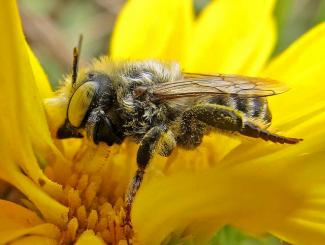
Image Credit: K Schneider
Leaf-cutting Bees (Megachilidae: Megachile, Lithurgopsis)
These are the larger members of the family Megachilidae. There are about 1500 species worldwide and 150 species in the US. All the females transport pollen to the nest on their bellies. All species are robust and cylindrical in order to fit into their burrow holes. Both sexes of most species have transverse fasciae (lines of bright white prostrate hair) on their abdomens. They have only 2 submarginal cells and very large strong jaws.
Megachile rotundata was the second bee domesticated for commercial alfalfa pollination by entomologists at Utah State and Oregon State Universities; it is currently a billion-dollar industry worldwide. Megachile rotundata was an accidental invasive bee in North America, presumably originally from the Middle East. Megachile rotundata is potentially a generalist-feeder, but in practice it is a strict specialist on alfalfa flowers. The bees are commercially raised in boxes of paper straws mounted on small trailers; a single trailer may provide many tens of thousands of nesting straws.
Megachile typically constructs nests with precisely geometric ovals cut from plant leaves for the cell “wall-paper” and cut circles for the doors. Cutting and transporting are interesting processes to observe; the females are quick workers. Whichever plant species they prefer locally is permanently scarred with crenulated leaves. Megachile are largely generalist for their pollen sources, but many species are specialized on the sunflower family, several on evening-primroses (Clarkia, Oenothera), several on the pea family (Lupinus), and 1 on cactus (the related genus Lithurgopsis in the Great Basin).


Bees of the genera Megachile (left) and Lithurgopsis (right) are generally large, black, and with bright white appressed abdominal fasciae (transverse bands). Lithurgopsis (both in North and South America) are specialists on Cactus; we have only 1 species in the PNW. Megachile are extremely diverse in the PNW with nearly 100 species. Some Megachile are known to be specialists and some are known to be generalists – but many await critical observations. Though it is generally assumed that Megachile nests in stems, because of the great success in domestication of the alfalfa bee, most species are probably facultative nesters in any type of tunnel they can find, either plant material or soil.


Male Megachile have a number of specialized morphological adaptations associated with mating – large spurs on their chests and prominent “boxing gloves” on their front feet. Notice the front feet of the Megachile on the left. Occasional Megachile do not have fasciae, like the lupine/locoweed (Lupinus, Astragalus) specialist common in our mountain meadows.


The leaf-cutting bees get their name from their habit of cutting circles and ovals off the edges of green leaves with which they line their cells and construct closing doors for the cells. A large number of local Megachile can greatly anger a backyard gardener due to the crenulations caused upon the bees’ favorite plant.